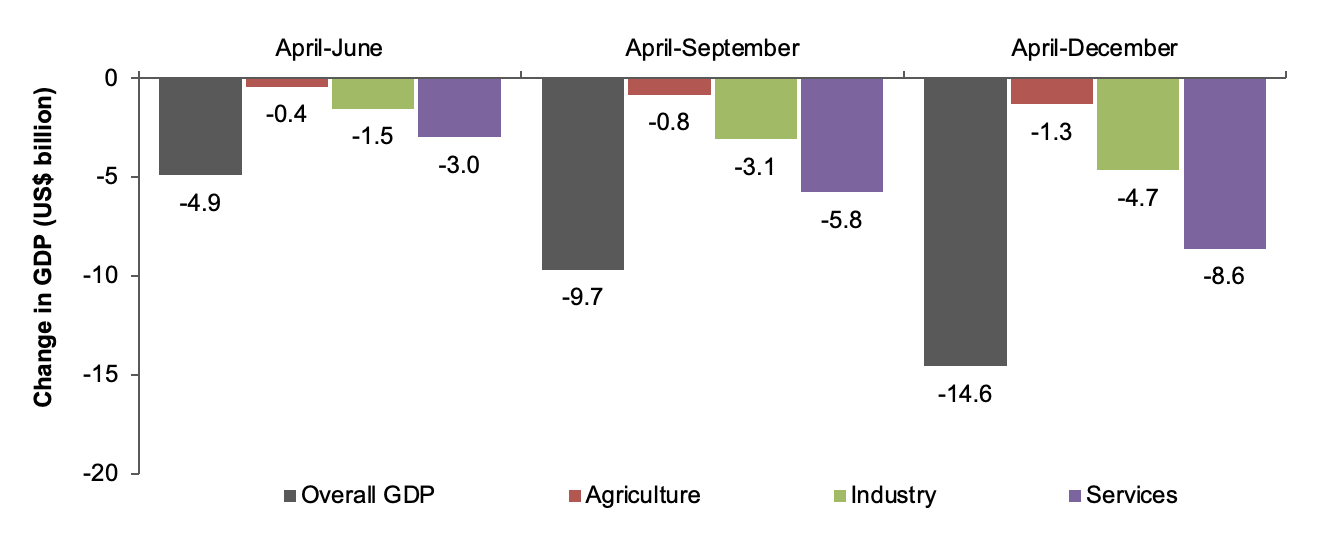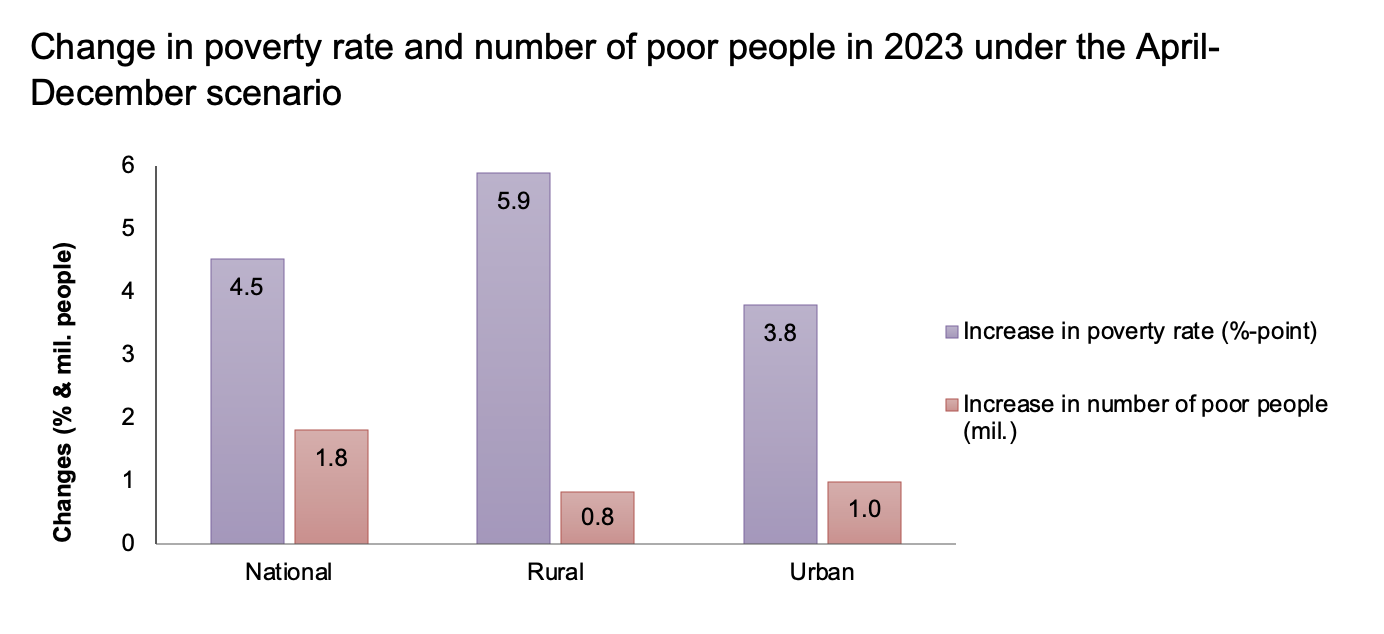Model: Sudan’s ongoing conflict could reduce economic output by half and push 1.8 million into poverty

The outbreak of war in Sudan on April 15 between the Sudanese Armed Forces (SAF) and the paramilitary Rapid Support Forces (RSF) caused major disruptions in economic activities in the capital Khartoum and other areas of the country. More than six months later, the conflict continues, and its impacts on Sudan’s economy and on livelihoods are intensifying. Those disruptions, which have also limited access to health facilities and other public goods, are creating an unfolding humanitarian emergency.
How has the war affected Sudan’s economy? Assessing those impacts is a challenge because Sudan is a relatively data-scarce country, especially in wartime. So, we opted to use an economic modeling approach. Using 2021 national statistics as a baseline, we modeled the war’s effects on economy-wide indicators and on household incomes. Our results indicate that the war’s impacts on the national economy and individual sectors are severe and could push as many as 1.8 million people into poverty.
We used a Social Accounting Matrix (SAM) Multiplier model for the purpose of this analysis. It is well-suited to measure the short-term impacts of unpredicted shocks such as the war in Sudan and it captures direct and indirect effects on national and sectoral production, household incomes, employment, and poverty.
To represent the impacts of the conflict in the modeling framework, we mapped its scale and spread using on-the-ground fighting and political developments. Our mapping included 10 out of the 18 Sudan states, with varying intensity of fighting: Khartoum state, the five Darfur states, the three Kordofan states, and Blue Nile state.
Simulated shocks at the level of economic sectors were designed based on the degree to which the main states that produce specific sectoral goods have been affected by the ongoing conflict. The magnitude of the shocks also varied depending on the extent of each sector’s centralization of production, as well as the level of intensity of violence in the producing states. We also considered governmental and non-governmental mitigation measures and interventions at the sectoral level. In addition, we considered seasonality in production, especially in the agricultural sector, to capture the stage of the value chain for each product being affected by the war.
We considered three scenarios reflecting possible duration of the war: 1) swift normalization, which captures the damage made by the war until the end of June 2023 (April-June); 2) prolongation of conflict, capturing the impact of the war until September (April-September), and 3) escalation of conflict, considering the continuation of the war until December 2023 (April-December).
The modeling indicates that the war resulted in losses of about $5 billion to Sudan’s economy as of June 30. That estimate doubled with the war extending beyond September, and the losses are expected to reach $15 billion if the war continues until the end of 2023—equivalent to 48% of Sudan’s gross domestic product (GDP). In the same scenario, with war continuing to the end of the year, reductions in sectoral GDP of industry, services, and agriculture are estimated at 70%, 49%, and 21%, respectively (Figure 1). These reductions in sectoral GDP are associated with the loss of an estimated 5.2 million jobs (almost half of the labor force) with 2.7 million, 2 million, and 400,000 jobs lost in services, industry, and agriculture, respectively.
Figure 1
 Source: Siddig et al, 2023; authors’ compilation based on Sudan’s SAM Multiplier model.
Source: Siddig et al, 2023; authors’ compilation based on Sudan’s SAM Multiplier model.
Agrifood system GDP (both on and off-farm), which represents about 33.6% of Sudan’s overall GDP, is expected to decline by 22% compared to 2021, the model shows, with overall losses of $2.2 billion if the war continues until the end of the year. Households are severely hit in this scenario, with their aggregate incomes declining by over 40% compared to 2021 levels. Income losses of urban households will be relatively higher than those of rural households—51% and 44%, respectively. Income to all production factors (labor, land, and capital) will decline by at least 48.3% compared to 2021. Labor income would decline by 50.8%, while capital income would decline by 46.5% relative to 2021. The reduction in employee income would be the highest for primarily educated workers, while the types of capital that would suffer the most are those used in the mining sector, declining by over 90%.
The national poverty rate is expected to increase by 4.5 percentage points compared to 2021 (Figure 2), with 1.8 million more people falling below the poverty line, and the total reaching 39.3 million. Rural areas are expected to witness a higher increase in the poverty rate (5.9 percentage points, or 800,000 people pushed into poverty) compared to urban areas (3.8 percentage points, 1 million people).
We also examined another calculation of the poverty rate. The government of Sudan and the World Bank developed a Poverty Reduction Strategy Paper (2021-2023), estimating the 2019 poverty rate at 61.1%, equivalent to 26.4 million people. Applying this estimate to our 2021 baseline data, the model indicates the poverty rate will increase to 65.6% if the war continues through the end of 2023—or that 2 million people will be new entrants to poverty.
Figure 2
 Source: Siddig et al, 2023; authors’ compilation based on Sudan’s SAM Multiplier model.
Source: Siddig et al, 2023; authors’ compilation based on Sudan’s SAM Multiplier model.
The model suggests that reaching a sustainable agreement between the SAF and RSF soon would protect 500,000 people from falling into poverty. Therefore, efforts and initiatives at the International, regional, and national levels are highly needed to stop the war.
Khalid Siddig is a Senior Research Fellow and Program Leader in IFPRI's Development Strategies and Governance (DSG) Unit based in in Khartoum, Sudan; Mariam Raouf is a DSG Senior Research Associate, based in Cairo; Mosab Ahmed is a DSG Senior Research Assistant based in Khartoum. This post is based on research that is not yet peer-reviewed.
Referenced working paper:
Siddig, Khalid; Raouf, Mariam; and Ahmed, Mosab O. M. 2023. The economy-wide impact of Sudan’s ongoing conflict: Implications on economic activity, agrifood system and poverty. Sudan SSP Working Paper 12. Khartoum, Sudan: International Food Policy Research Institute (IFPRI). https://doi.org/10.2499/p15738coll2.136843
This study was prepared with the financial support of the United States Agency for International Development (USAID). The authors are grateful for the useful suggestions provided by Charlotte Hebebrand, IFPRI’s Director of Communications and Public Affairs.